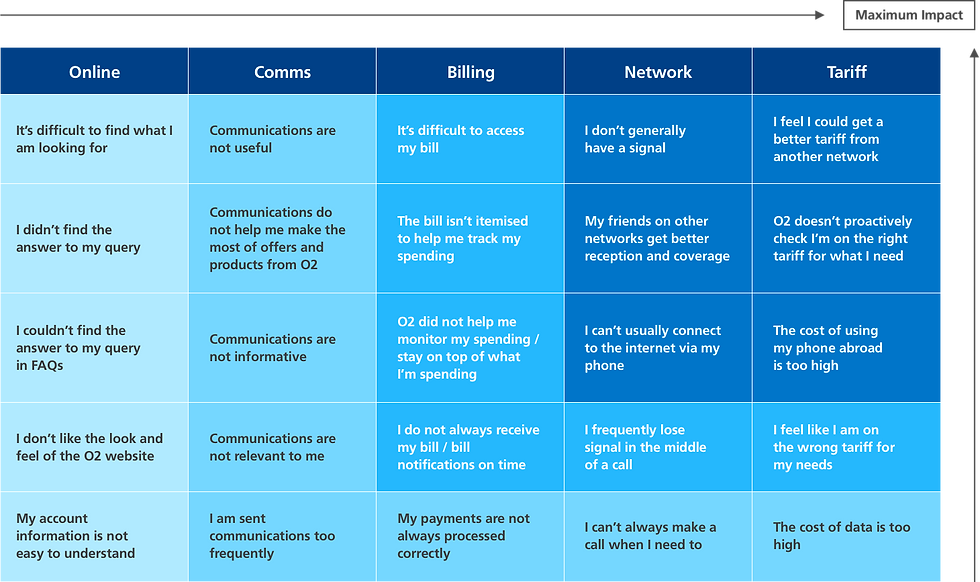



A brand transformation project aimed at enhancing
customer perceptions, boosting satisfaction at every
touchpoint, and regaining market share.


Project
Role: Senior CX/UX Designer
Team: O2 Stakeholders, 1x Director of Service Design, 1x Service
Design Lead, 1x Business Designer, 1x UX Designer, 1x UI Designer.
Brief
In the last three years, O2 has experienced a decline in market share, coupled
with a significant drop in customer satisfaction. In response, O2 enlisted the
services of EY Seren to pinpoint the challenges faced by their customers and
formulate a strategy aimed at reversing this downward trend.
O2’s 3 Years Customer Satisfaction Goals
O2 must transform to respond to current and future market challenges and opportunities

The objective of Customer Strategy is to
deliver commercial value through leveraging
deeper customer understanding

Quantitative Research

Value Irritant Matrix
We've compiled O2's data and UKCSI reports into a Value / Irritant Matrix. This guided us in identifying areas
where simplification, leveraging, automation, or elimination can be applied for service improvement.



Customers
10 x 3 Hours F2F
36 x 7 days diary tasks

Retail Stores
6 Respondants
3 Stores

Call Centers
8 Respondants
2 Centers

Stakeholders
12 Respondants
2 Rounds
Qualitative Research
Interviews
To gain insights into O2's various touchpoints, and the customer journeys within them, as well as to
identify customer pain points and their valued aspects, we conducted a series of interviews.
Research Planing

Opportunities for improving CSI are concentrated
around what’s important for customers

O2 Customer Lifecycle
The user research has shed light on the current customer lifecycle, providing valuable insights into customers’ relationships with O2.
This perspective helped us grasp the specific intent behind each step, serving as a foundation for our design approach.




Personas
The user research also provided essential insights into O2's customer base, their objectives,
and points of frustration. This allowed us to pinpoint opportunities for enhancing services
and catering to the unique needs of each customer cohort more effectively.




From all the design work, we have produced a list of implication questions the
business needed to answer and an agile UX backlog for the next Design phase.
6. Agile UX Backlog

6. Business Implications





We identified key concepts in the abstracts that we wanted to test with customers. We produced wireframes
that we used to create prototypes. We then tested them with users and produced reports of the findings
5. Wireframes

5. User Testing Report




4. Abstracts

4. Storyboards

4. Omni-channel Maps


We took the blueprint sub-journeys and went into more detail on them
producing any combination of storyboards, abstracts or omni-channel journeys.





3. Lifecycle Blueprints
We identified key sub-journeys within the Lifecycle that we felt could be a great
point of differentiation for O2 and developed blueprints for each of them.





2. Customer Lifecycle
We created an entirely new and improved Lifecycle, incorporating enhancements to existing journeys but also seamlessly integrated the newly proposed service offerings.




We used a combination of Task Models and User Flows to
redefine the new Customer Lifecycle incorporating
enhancements to existing journeys based on our findings.
1. Flows

1. Task Models

CX Planning
We planned a series of improvements across the customer lifecycle, spanning various touchpoints, and
seamlessly integrating new service offerings. We produced a series of artefacts to illustrate those changes.


Brand Transformation
Through our desk research, coupled with quantitative and qualitative analysis, we gained a deep understanding of network
providers' customers. We identified their pain points, frustrations, and areas where we could enhance their experience. Building on
this information and aligning it with O2's objectives, we initiated HMW sessions to further develop a new customer experience.




User Flows & Task Models
We meticulously mapped out every journey, through user Flows and Task Models, to gain an
in-depth comprehension of the existing O2 experience. During this mapping, we implemented
suggested enhancements derived from our qualitative and quantitative research.
I Discover: Explore
Get a better/new deal on my phone

Customer Lifecycle
We organised these newly enhanced journeys, grouping them into a new O2 Customer Lifecycle.
This Lifecycle served as the foundation for the new O2 customer experience.

Lifecycle Blueprints
We then identified key sub-journeys within the new Lifecycle that we felt could be a great
point of differentiation for O2 and developed blueprints for each of them which included
critical quantitative and qualitative data we collected during the research phase.

Storyboards
We further refined certain sub-journeys, providing more detailed illustrations of
specific sections of the blueprints from the perspective of our personas.

Omni-channel Maps
For specific journeys, we crafted omnichannel maps to illustrate how
each touchpoint seamlessly integrates with one another.

Abstracts
We also created abstracts for certain digital sub-journeys to illustrate the
relationship between digital touchpoints and the real world.







Wireframes & Prototypes
Once the abstract journeys had been validated by the stakeholders, we proceeded to develop wireframes for them.
These wireframes were then prototyped, allowing us to conduct user testing and gather valuable feedback.






Conclusion
The goal of this 4-month contract was to formulate a compelling strategy aimed at helping O2 in achieving their OKRs.
Our measure of success was ensuring the satisfaction of the stakeholders with the quality of our work, with the hope that
they would hire EY Seren to develop and implement the strategy we had crafted. This indeed came to fruition, as within
the week following the conclusion of our contract, O2 signed a £2M agreement to put our strategy into action.


Delivery
Following the user testing and compilation of feedback, we created a handover document containing all our
research findings and the artefacts we produced. It also included an explanation of the business implications and
a detailed UX Backlog outlining the effort required for the recommended changes to be implemented.






